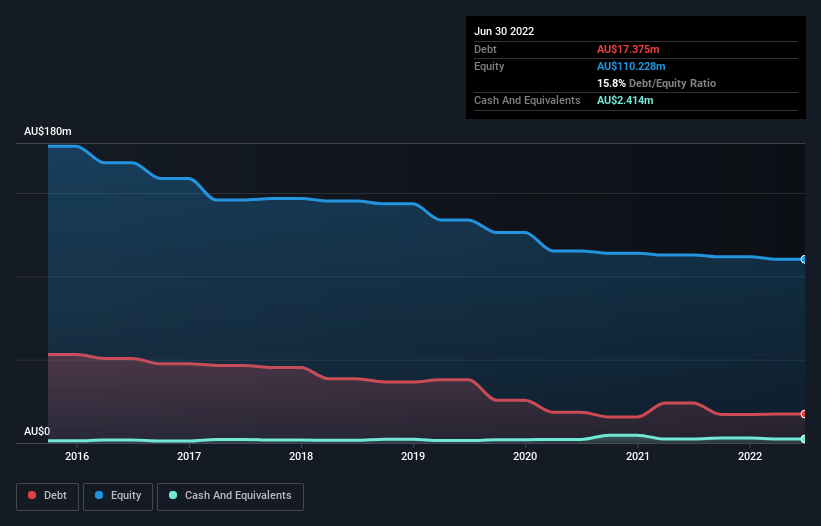- Australia
- /
- Trade Distributors
- /
- ASX:BOL
Here's Why Boom Logistics (ASX:BOL) Can Manage Its Debt Responsibly

Legendary fund manager Li Lu (who Charlie Munger backed) once said, 'The biggest investment risk is not the volatility of prices, but whether you will suffer a permanent loss of capital.' So it seems the smart money knows that debt - which is usually involved in bankruptcies - is a very important factor, when you assess how risky a company is. As with many other companies Boom Logistics Limited (ASX:BOL) makes use of debt. But should shareholders be worried about its use of debt?
What Risk Does Debt Bring?
Debt and other liabilities become risky for a business when it cannot easily fulfill those obligations, either with free cash flow or by raising capital at an attractive price. In the worst case scenario, a company can go bankrupt if it cannot pay its creditors. However, a more common (but still painful) scenario is that it has to raise new equity capital at a low price, thus permanently diluting shareholders. Of course, debt can be an important tool in businesses, particularly capital heavy businesses. When we think about a company's use of debt, we first look at cash and debt together.
See our latest analysis for Boom Logistics
What Is Boom Logistics's Net Debt?
As you can see below, Boom Logistics had AU$17.4m of debt at June 2022, down from AU$24.0m a year prior. However, it also had AU$2.41m in cash, and so its net debt is AU$15.0m.

A Look At Boom Logistics' Liabilities
The latest balance sheet data shows that Boom Logistics had liabilities of AU$62.0m due within a year, and liabilities of AU$18.5m falling due after that. Offsetting these obligations, it had cash of AU$2.41m as well as receivables valued at AU$41.5m due within 12 months. So its liabilities outweigh the sum of its cash and (near-term) receivables by AU$36.7m.
While this might seem like a lot, it is not so bad since Boom Logistics has a market capitalization of AU$62.0m, and so it could probably strengthen its balance sheet by raising capital if it needed to. However, it is still worthwhile taking a close look at its ability to pay off debt.
We use two main ratios to inform us about debt levels relative to earnings. The first is net debt divided by earnings before interest, tax, depreciation, and amortization (EBITDA), while the second is how many times its earnings before interest and tax (EBIT) covers its interest expense (or its interest cover, for short). This way, we consider both the absolute quantum of the debt, as well as the interest rates paid on it.
Boom Logistics has a very low debt to EBITDA ratio of 0.64 so it is strange to see weak interest coverage, with last year's EBIT being only 2.4 times the interest expense. So one way or the other, it's clear the debt levels are not trivial. It is well worth noting that Boom Logistics's EBIT shot up like bamboo after rain, gaining 80% in the last twelve months. That'll make it easier to manage its debt. The balance sheet is clearly the area to focus on when you are analysing debt. But it is Boom Logistics's earnings that will influence how the balance sheet holds up in the future. So when considering debt, it's definitely worth looking at the earnings trend. Click here for an interactive snapshot.
Finally, a business needs free cash flow to pay off debt; accounting profits just don't cut it. So it's worth checking how much of that EBIT is backed by free cash flow. Over the last two years, Boom Logistics actually produced more free cash flow than EBIT. That sort of strong cash generation warms our hearts like a puppy in a bumblebee suit.
Our View
Boom Logistics's conversion of EBIT to free cash flow suggests it can handle its debt as easily as Cristiano Ronaldo could score a goal against an under 14's goalkeeper. But the stark truth is that we are concerned by its interest cover. Taking all this data into account, it seems to us that Boom Logistics takes a pretty sensible approach to debt. While that brings some risk, it can also enhance returns for shareholders. The balance sheet is clearly the area to focus on when you are analysing debt. However, not all investment risk resides within the balance sheet - far from it. For example - Boom Logistics has 2 warning signs we think you should be aware of.
If you're interested in investing in businesses that can grow profits without the burden of debt, then check out this free list of growing businesses that have net cash on the balance sheet.
Valuation is complex, but we're here to simplify it.
Discover if Boom Logistics might be undervalued or overvalued with our detailed analysis, featuring fair value estimates, potential risks, dividends, insider trades, and its financial condition.
Access Free AnalysisHave feedback on this article? Concerned about the content? Get in touch with us directly. Alternatively, email editorial-team (at) simplywallst.com.
This article by Simply Wall St is general in nature. We provide commentary based on historical data and analyst forecasts only using an unbiased methodology and our articles are not intended to be financial advice. It does not constitute a recommendation to buy or sell any stock, and does not take account of your objectives, or your financial situation. We aim to bring you long-term focused analysis driven by fundamental data. Note that our analysis may not factor in the latest price-sensitive company announcements or qualitative material. Simply Wall St has no position in any stocks mentioned.
About ASX:BOL
Boom Logistics
Provides lifting solutions to mining and resources, infrastructure and construction, wind, energy, utilities, industrial maintenance, and telecommunications sectors in Australia and the Pacific region.
Good value with adequate balance sheet.

